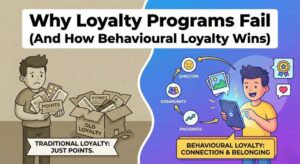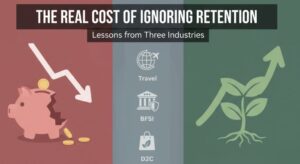In digital marketing, interactivity is increasingly recognized as a valuable tool to complement conventional communication strategies. Campaigns that engage users through two-way experiences often enable deeper audience connection and provide richer behavioural insights.
This case study outlines our approach to building a custom gamified experience — a word search puzzle — developed for a client iWant, in the OTT entertainment sector. The solution was designed to run seamlessly within MoEngage’s On-Site Messaging framework and built with long-term reusability in mind.
Objective
The primary goals were:
- To create an engaging, brand-aligned activity users could participate in directly on the website.
- Collect meaningful data based on how users interact with the activity, rather than through traditional forms or surveys.
- Build a modular and adaptable solution that can be easily customized for future campaigns.
Overview
We developed a Word Search Game that:
- Was accessible via MoEngage’s on-site messaging (OSM)
- Required no backend or third-party libraries
- Worked across mobile and desktop environments
- Could be easily customized for other use cases
- Tracks User Behaviour via Moengage’s event tracking
Martech Word Search
Find the hidden marketing terms in the grid. Click and drag to select a word. Can you find all five?
Find The Words
Congratulations!
You're a true martech wizard! You found all the words.
Game Mechanics
The game experience was structured as follows:
- Puzzle Grid: A 9×9 board presented to the user, containing five words related to the show’s characters or themes. Words were placed horizontally and vertically.
- Trait Tracking: The game captures the first three words each user found — representing the traits or themes that stood out most naturally to them.
- Dynamic Reveal: Based on the user’s selections, the game revealed a character from the show whose profile aligned with the discovered traits. This included:
- Character name
- Visual illustration
- Short description
- A call-to-action encouraging the user to subscribe.
- Interaction Feedback: Visual animations like confetti and fireworks made the experience more memorable, especially on successful word discoveries.
- Event Tracking: All key interactions (game start, completion, exit, CTA click) were tracked via MoEngage’s Web SDK for behavioural insights.
Built for Adaptability
A key design principle behind this project was modularity. The entire experience was created using standard HTML, CSS, and JavaScript, which enabled:
- Rapid re-theming or styling for different brands or promotions
- Easy replacement of word banks and character sets
- Support for alternate formats such as trivia, polls, or matching games
This structure ensured that the codebase could be reused across different campaign types with minimal adjustments — an efficient model for teams working across multiple verticals or product categories.
Strategic Benefits
While this specific implementation was built to support a show launch, the core concept is applicable across industries and formats. Gamification strategies like this can offer:
- Voluntary participation: Users engage with content by choice, improving relevance
- Behavioural insight: Actions provide indicators of interest or personality traits
- Personalized experiences: Results and CTAs can be tailored based on user input
- Data privacy alignment: user insights are captured through direct interaction, not assumptions
Additionally, embedding gamified experiences directly into platforms like MoEngage enables real-time performance tracking and segmentation without disrupting existing marketing operations.
Conclusion
This project demonstrates how gamification, when thoughtfully integrated, can enrich campaign experiences without adding unnecessary technical complexity. By prioritizing interactivity, customization, and data usefulness, we were able to deliver a marketing component that balanced user engagement with strategic insight.
As brands continue to look for ways to make their digital experiences more interactive, solutions like this provide a flexible and scalable foundation for future innovation.



